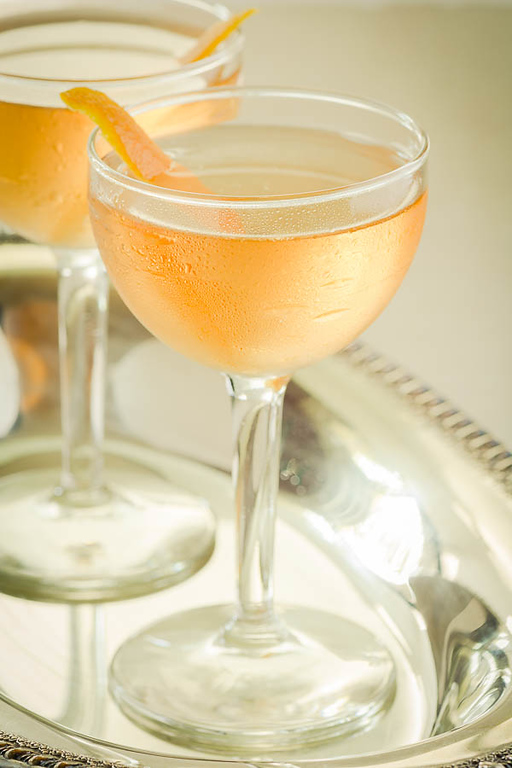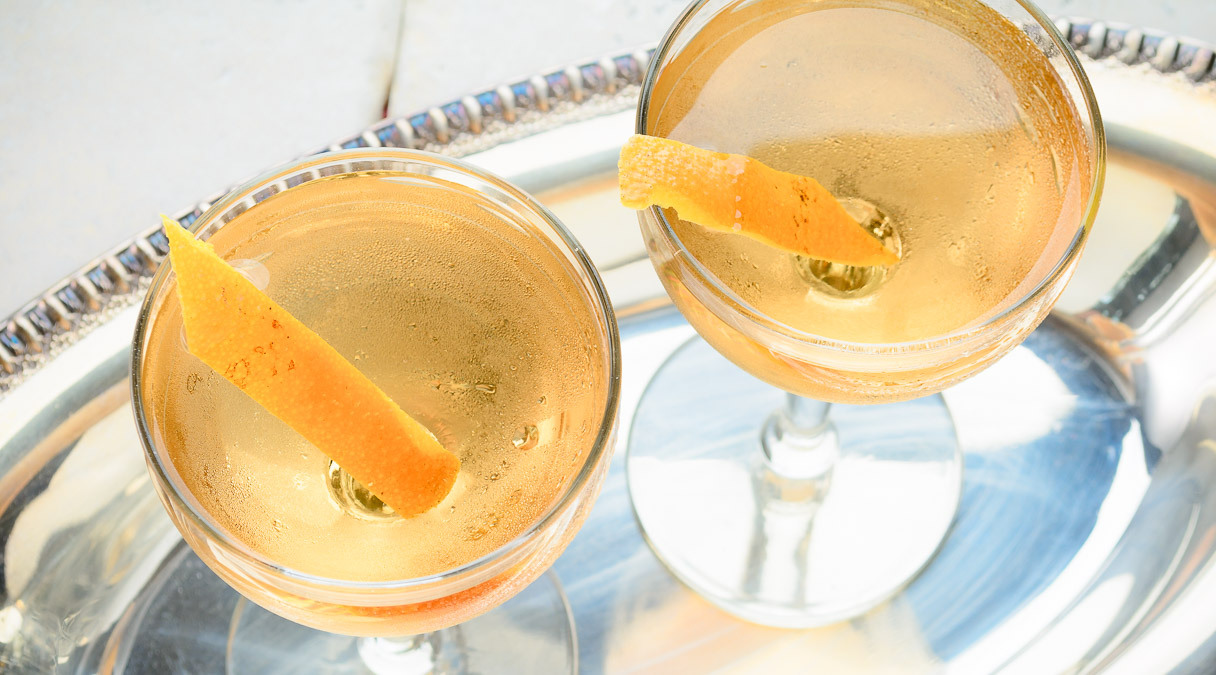One of the old-school cocktails that made a comeback in the last fifteen years is the Opera Cocktail.
The Opera is a blend of gin, Dubonnet, and liqueur—and that’s where the story gets interesting.
In fact, there are two versions of the Opera. (At least.)
The original Opera, as published by Jacques Straub in 1914, was a tiny drink, a half-jigger each of gin and Dubonnet, with two barspoons of crême de mandarine as a sweetener.
In 1930, Harry Craddock published an alternative version in The Savoy Cocktail Book. It was still a gin and Dubonnet drink, but Craddock substituted Maraschino for the crême de mandarine (four parts gin, one part each Maraschino and Dubonnet). The recipe suggests a Maraschino-heavy Martinez. I have no idea what he was thinking to make such a change—mandarine and Maraschino are not at all alike—though it suggests that Maraschino might have been going through a fashion moment at the time, at least at the Savoy.
Such is the sticking power of The Savoy Cocktail Book that Craddock’s Maraschino version became the model for nearly every modern incarnation of the Opera. Alas! that Straub’s orange version is all but forgotten.
My first encounter with the Opera—in its Maraschino incarnation—was in Hollinger and Schwartz’s The Art of the Bar, which follows Patrick Duffy’s Savoy-inspired recipe, but cuts back the Maraschino a bit, and adds a dash of orange bitters—a step in the right direction, and a hat-tip to Straub’s original.
But it just wasn’t a cocktail that made me want to come back and for more.
In fact, the reason I’ve not written about the Opera until now is because, given my low tolerance for Maraschino, I just plain didn’t like it. And I don’t write about drinks I don’t like.
It was only recently that I came across the orange version in Straub’s Drinks, and finally changed my mind about this old classic.
Straub’s version looks like this:
Jacques Straub, Drinks, 1914
- ½ jigger Dubonnet
- ½ jigger dry gin
- 2 barspoons crème de mandarine.
Twist orange peel on top. Shake, strain and serve.
Equal parts of gin and Dubonnet is very sweet and very herbal, and not really a match for modern tastes, though I suppose that if Dubonnet’s mix of herbs and quinine is something you pursue as a daily aperitif, then this original formula might be right up your alley.

If your tastes are like mine, and Dubonnet is more of an occasional cocktail flavoring than a standard tipple, a simple adjustment to a more gin-heavy ratio works very well.
A modernized, upsized version of the Opera looks something like this:
Opera Cocktail
- 2 oz London Dry gin (Tanqueray)
- ½ oz Dubonnet
- ½ oz orange curaçao (Ferrand)
Stir all ingredients with ice until cold. Strain into a chilled cocktail stem. Express and garnish with orange peel.
Dubonnet is like gin-and-tonic in the sense that it was the French effort to make quinine more palatable to the soldiers of empire. And just as gin and tonic seem the quintessential British tools for fighting malaria in their far-flung empire, the vermouth-based Dubonnet seems a natural French styling in their Foreign Legion’s struggle against malaria in North Africa.
London Dry gin is definitely the gin style for the Opera, and Tanqueray, with its very juniper-forward flavor profile, stands up well to the chaos of flavors at work in this drink.
I look forward to experimenting with mandarine in this recipe someday, but I haven’t found a good one in my region yet, so the more commonly found curaçao stands in. The Ferrand fairly dry, and works well for my tastes, but I would expect Cointreau or Grand Marnier to work well, too.
The Opera starts with an orange, slightly herbal nose. The first sip is about gin, then the herbs and bitter orange of the Dubonnet. The herbs are replaced by a passing wave of fruity sweetness from the curaçao, and then the finish is full of gin, and a return of the Dubonnet’s herbality and bitters.
You’ll want to drink the Opera dead cold; it gets sweeter and less subtle as it warms.
So there you have it: two sweeteners, two Operas, and a testament to the power of the Savoy Cocktail Book. There’s a world of difference between the mandarine (or curaçao) version and the Maraschino version, and I recommend that you try them both.
As for me, I’ll stick with the curaçao, and raise a toast to Jacques Straub!
“Two Nights at the Opera” at cold-glass.com : All text and photos © 2015 Douglas M. Ford. All rights reserved.

Those of us in the U.S. can only get the inferior American made Dubonnet, unfortunately. If you can make your way to Canada you can get the real French brand (which is only rouge, blanc is a U.S. creation). And in Quebec you can get Franc’s 2nd most famous quinquina, St. Raphael (rouge & blanc). I’ll try this cocktail with the original ingredients (I have the excellent Don Ciccio Mandarino Liqueur as well as the Ferrand) and see how it goes
I’ve never tried the non-USA Dubonnet; I look forward to sampling it sometime soon. And I’m eager to see your comparison of the mandarins and curaçao Operas. Thanks!
>
Ok, I’ve been experimenting here, using the French Dubonnet (I don’t have any of the fake US version in house, as a friend from Toronto supplies me regularly with the real thing)
The Straub version is, as you said, very sweet, though I can certainly see it as a short aperitif in its era. In this I used the 2 bar spoons of Don Ciccio & Figli Mandarinetto. A very fine product, produced not in Italy but in Washington D.C.
I made your take on the drink, using the Ferrand in one and the Ciccio in the other, both with 2 oz of gin, and .5 of the modifiers. While the Ferrand was tasty, the Mandarinetto shined, brightening the edges and rounding the drink off, and complementing the bitter orange of the Dubonnet.
But I kept thinking of a balance between the Straub and your version, as well as the Savoy, though I don’t think the Maraschino would make his a better drink. Au contraire! So I offer up this remix….again, with the specific ingredients that are not available everywhere (the Napoleon Mandarin liqueur is good, though I don’t have any in house currently). So I did this –
1.5 oz London Dry Gin
1 oz Dubonnet
.25 oz Don Ciccio & Figli Mandarinetto
Stir with ice and strain
This tastes, to me, exactly like your description, “The Opera starts with….”. The split between the gin and the quinquina balances them both better, and the drink is less sweet. And the raised amount of Mandarin liqueur is still not too sweet to ruin it. It’s not an aperitif anymore, but a cocktail. I would retain the same garnishing you used.
Thanks for letting me join in the fun!
A most excellent experiment, Brother, and one I look forward to duplicating as soon as I can. I’ll have to see if one of my local shops can order in some of the Ciccio mandarine, it sounds like it does provide a worthwhile improvement.
Thanks for taking time to make comparisons (somebody has to do the hard work!), and for reporting back.
So, if I understand well, the US Dubonnet is white ? I know only the red one.
I’ll try the recipe one of these days, I have Red Dubonnet, gin and Mandarine Napoléon.
Both red and white Dubonnet (“rouge” and “blanc” in Dubonnet-speak) are manufactured in the US by Heaven Hill Distilleries. As I understand it, the white version is a late-20th century invention; the red would certainly have been in the original Opera.
Thank you ! I’ve never seen the white here in Europe. I’ve tried the cocktail: it’s really tasty and I think it will become one of my favorites !
Did you use the Dubonnet Rouge for the cocktails in your photos? (The Blanc is very elusive to me, even living a major US cocktail city.)
Rouge, yes.
>
This looks phenomenal. I just started a batch of blueberry balsamic liqueur that will take a week in a dark cool cabinet to finish. Can’t wait!
Thanks! I’d be interested to hear how you use the liqueur.
Love to hear about retro recipes! Have a great weekend x
Thanks! You, too.
>
Interesting, these….because the pictures are lovely yellow-pale drinks…but Dubonnet is VERY red.
So…how do that work out?
Yes, that’s a curious color, but it seems to be how the Dubonnet works when well-diluted. I hadn’t thought to question it before, so thanks for asking.
I’d be interested in trying this as 2oz gin, 1oz Dubonnet, and a few dashes of orange bitters. A kind of souped-up Gin and It …